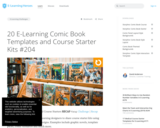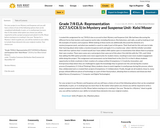
"...course starter kits using the popular comic book style designs. Examples include graphic novels, template packs, comic scenarios and much more. "
- Subject:
- English Language Arts
- Material Type:
- Activity/Lab
- Date Added:
- 05/06/2020

"...course starter kits using the popular comic book style designs. Examples include graphic novels, template packs, comic scenarios and much more. "

This picture book is designed to introduce children to the Earth's atmosphere and its importance to life on Earth. It also introduces how the addition of new gases (e.g., ozone) contributes to changing the quality of air we breathe. With an understanding of how our atmosphere works, we can begin to understand how our activities may be contributing to some of those changes in air quality.

This is a children's science story about gravity (title translated: The World of Copocuqu: Queen Gravity and King Mass). Learners will read about the force of gravity and how it relates to the mass of a body. The story takes place in an asteroid in which all its inhabitants talk in the form of questions or the world of Copoqucu. The story ends with a magic secret (or learning capsule), which reflects in synopsis the science message that the child would take with him or her.

For your project in our Mystery and Suspense unit you will have a choice of one of the following options that can be completed individually, in pairs, or in small groups (no more than 3). No matter what option you choose you will be required to write a project proposal and submit it to Ms. Moser before moving on to creating it. Use your “Recipe for a Mystery” sheet to guide you; you will be marked on your ability to include those elements into your original creation. Your choices are:

This is an activity about sunlight as an energy source. Learners will create a plant box and observe that a plant will grow toward the Sun, its primary source of energy. This hands-on activity is an additional lesson as part of the book, The Day Joshua Jumped Too Much.

Learners will read or listen to a story about two sisters, Marisol and Sofia, as they explore the Sun's role in the water cycle. Additionally, numerous extension resources are included in the accompanying educator guide, such as suggestions for no-cost language arts activities, links to further science activities, a book walk cue chart to guide classroom discussion before, during, and after the story, a graphic organizer, and alignments to the National Science Education Standards (NSES) and the Next Generation Science Standards (NGSS).